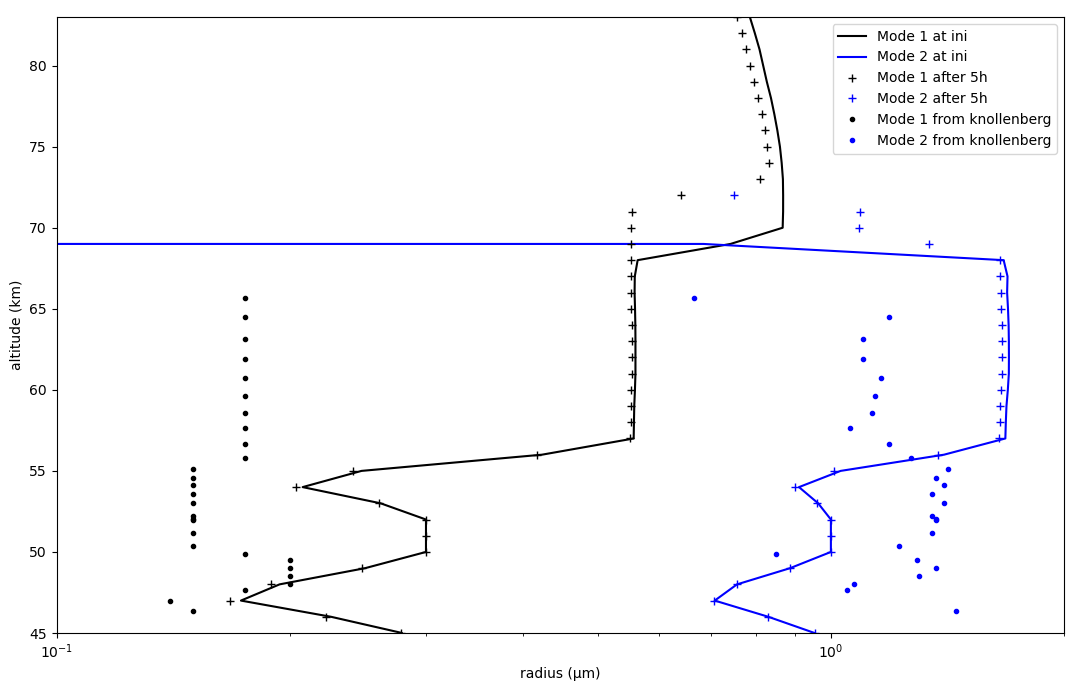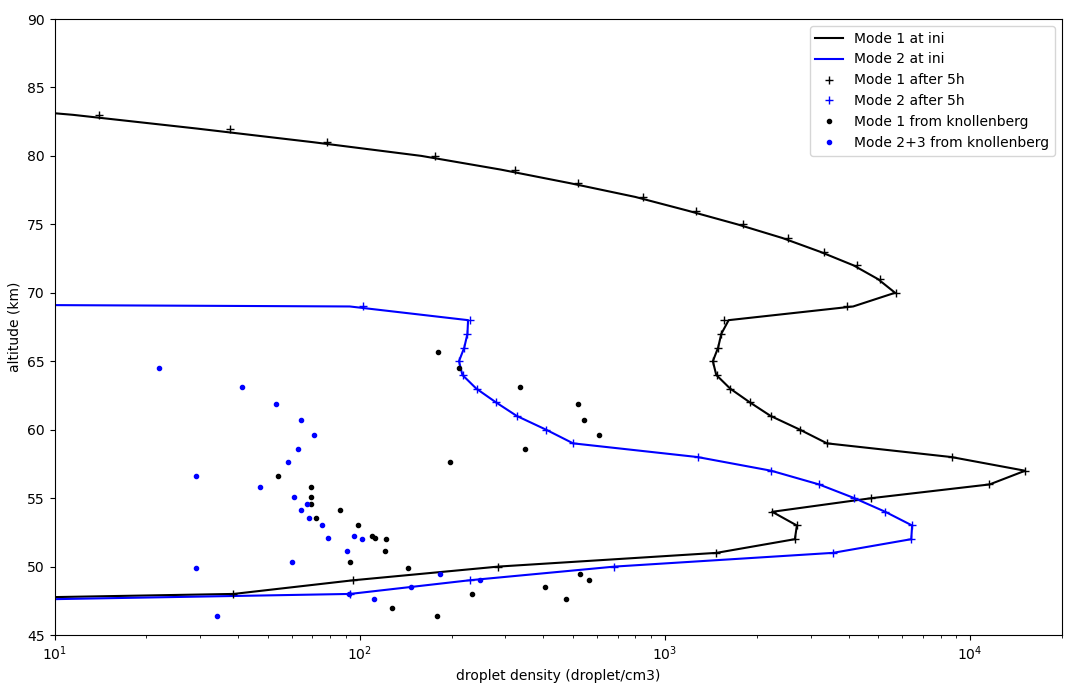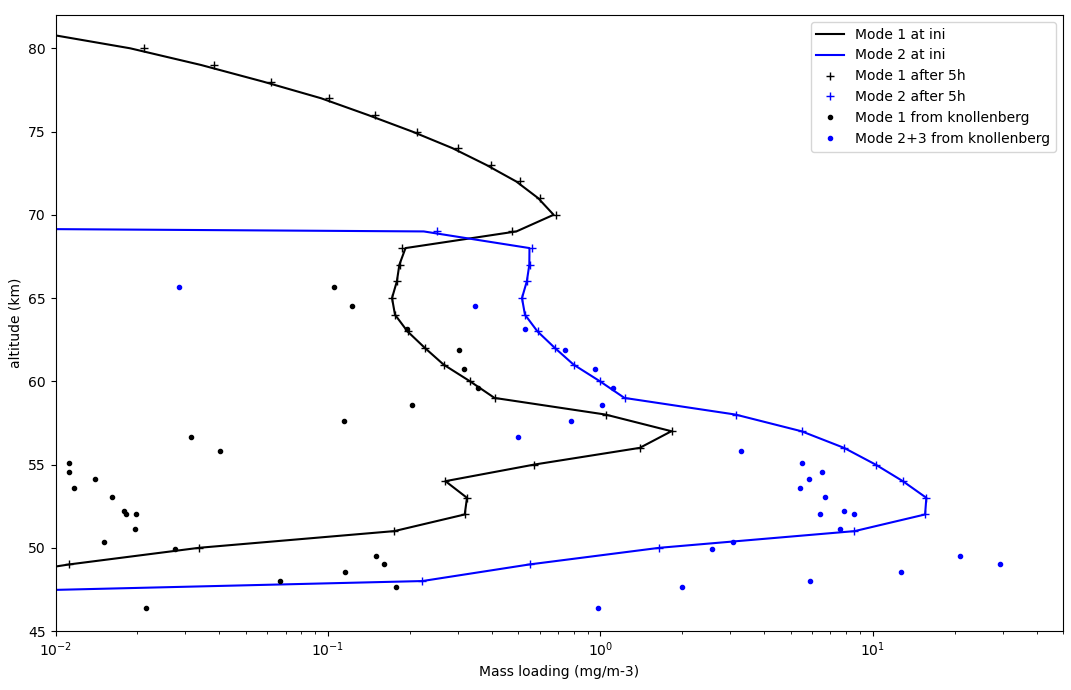Introducing detailed microphysics into the Venus Planetary Climate Model: model validation in one dimension
- LATMOS, CNRS, Sorbonne Université, Université Versailles St Quentin, Paris, France
Introduction
Venus has a unique cloud structure, with a global, three-layer cloud cover extending from 50 to 70 km in altitude. The cloud droplets are composed of sulphuric acid solution (70-95% in weight) and the size distribution is bi- or trimodal based on observations. These three modes have radii of around 0.3, 1 and 3 micrometers [1].
Several 1D models of the microphysics of Venus' clouds already exist [2-5]. This work aims to couple a microphysics model and the global climate model for Venus named Venus PCM, in order to have a coherent evolution of our clouds and chemistry. The Venus PCM [6,7] is a GCM that includes a complete chemical scheme [8], a radiative transfer scheme and currently a simple cloud parametrization [8]. This cloud scheme assumes that the cloud profile is always in equilibrium. So at each time step, all the clouds are evaporated and then recondensed at equilibrium. This scheme is therefore highly dependent on and strongly coupled to the GCM chemical model.
Method
We couple the MAD-VenLA model from the work of Guilbon and Määttänen[9] with the one-dimensional (1D) version of the Venus PCM. MAD-VenLA is a modal model that describes two particle modes that have a lognormal form with a fixed standard deviation. MAD-VenLA includes a scheme of homogeneous nucleation Määttänen [11], a simplified parametrization of heterogeneous nucleation, Brownian coagulation, condensation and evaporation[9]. In addition, MAD-VenLA incorporates a numerical process, mode-merging [10], that allows to transfer particles from a mode to another. We have parametrized vertical transport through a prescribed eddy diffusion coefficient profile based on the work of Lefèvre 2024 [12], with the aim of having realistic vertical transport of all species. A simple sedimentation scheme will be added as well, based on the equation of Stokes-Cunningham.
Results
We will present the results of our model with the initial state taken as the equilibrium cloud distribution from Stolzenbach[8]. We let the cloud evolve during several Earth days. The 1D simulations should not be too long, since they do not include advection and large-scale dynamics that are very important in the atmosphere of Venus. The first short runs are made to test the behavior of the cloud model and its 1D implementation, before moving on to 3D simulations.
The aim of the first test is to study how the coupling between the microphysics and chemistry behaves in presence of parametrized vertical transport. From these tests we can see that the cloud remains in equilibrium over a more or less long period, maintaining a structure in line with what is expected in mass (Figure 3), and a bit less with concentration (Figure 2) and radius (Figure 1).
Other tests are in preparation, notably on nucleation that was not used in the initialization of the model. We will test how efficiently homogeneous nucleation will be able to replenish the cloud particle population, and thus get an idea of how much additional particle formation through heterogeneous nucleation would be needed. We will also test initializing the model without clouds, letting nucleation take care of the cloud formation.
This 1D study is only the first step in a larger project, and in particular it prepares the future 3D simulations. For the future 3D simulations an important choice is the microphysical time step. The length of the time step is a crucial issue for a planet where the duration of a day is of the order of 117 Earth days. Currently, our timestep (3 minutes) is the same for the chemistry and microphysics. This is sufficient for most of the processes, except for nucleation that is a very rapid process and might need a dedicated time step. The second important point to address is heterogeneous nucleation. Currently, this process is parametrized in a very simple way that does not really account for all the physics involved. In addition, the existence and nature of condensation nuclei in the atmosphere of Venus are unknown. The choice of the potential condensation nuclei and the complexity with which to take them into account is one of the questions we want to address.

Figure 1: Radius profile in micrometer of mode 1 (in black) and mode 2 (in blue) particles at the initialization (full line) and after 5 hours of simulation (crosses). The outputs are compared to the Knollenberg data (dots).

Figure 2: Droplet density profile (in droplet.cm-3) of mode 1 (in black) and mode 2 (in blue) particles at the initialization (full line) and after 5 hours of simulation(crosses). The outputs are compared to the Knollenberg data (dots). Since MAD-VenLA is only composed of 2 modes, we sum up the mass of the mode 2 and mode 3 from the Knollenberg data (dots).

Figure 3: Mass-loading profile (in mg.m-3) of mode 1 (in black) and mode 2 (in blue) particles at the initialization (full line) and after 5 hours of simulation (crosses). The outputs are compared to the Knollenberg data (dots). Since MAD-VenLA is only composed of 2 modes, we sum up the mass of the mode 2 and mode 3 from the data (dots).
References
- R. G. Knollenberg, D. M. Hunten, J. Geophys. Res. 85, 8039–8058 (1980).
- T. Imamura, G. L. Hashimoto, J. Geophys. Res. 103, 31349–31366 (1998).
- E. P. James, O. B. Toon, G. Schubert, Icarus. 129, 147–171 (1997).
- K. Mcgouldrick, O. Toon, Icarus. 191, 1–24 (2007).
- M. Yamamoto, M. Takahashi, J. Geophys. Res. 111, 2006JE002688 (2006).
- G. Gilli et al., Icarus. 281, 55–72 (2017).
- S. Lebonnois, N. Sugimoto, G. Gilli, Icarus. 278, 38–51 (2016).
- A. Stolzenbach, F. Lefèvre, S. Lebonnois, A. Määttänen, Icarus. 395, 115447 (2023).
- A. Määttänen, S. Guilbon, J. Burgalat, F. Montmessin, Advances in Space Research. 71, 1116–1136 (2023).
- E. Whitby, F. Stratmann, M. Wilck, Journal of Aerosol Science. 33, 623–645 (2002).
- A. Määttänen et al., JGR Atmospheres. 123, 1269–1296 (2018).
- M. Lefèvre et al., Geophysical Research Letters.
How to cite: Streel, N., Määttänen, A., and Lefèvre, F.: Introducing detailed microphysics into the Venus Planetary Climate Model: model validation in one dimension, Europlanet Science Congress 2024, Berlin, Germany, 8–13 Sep 2024, EPSC2024-422, https://doi.org/10.5194/epsc2024-422, 2024.